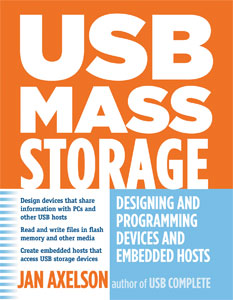Home > USB Mass Storage > Contents
USB Mass Storage
Contents
Introduction
1 Mass Storage Basics
When to Use a Storage Device
Benefits
Other Considerations
Requirements
Devices
Embedded Hosts
Selecting a Media Type
Drive Mechanisms
Addressing Methods
Reading and Writing Considerations
Removable Media and Devices
Hardware Interfaces
Hard Drives
Technology
Interfaces
Flash Memory
Technology
Options for Flash Memory
MultiMediaCard
SD Memory Card
CompactFlash
2 Supporting USB
The Interface in Brief
Hosts and Devices
Host Responsibilities
Device Responsibilities
Bus Speeds
Endpoints
Transfer Types
Transactions
The Data Toggle
Descriptors
Mass Storage Requirements
Choosing a Device Controller
Controllers with Support for Flash Memory
Controllers with support for ATA/ATAPI
Firmware Options
Microchip PIC18F4550
Architecture
Firmware Support
The USB Controller
3 The USB Mass Storage Class
Requirements
Specifications
Logical Block Addressing
Mass Storage Requests
Descriptors
Device Descriptor
Configuration Descriptor
Interface Descriptor
Endpoint Descriptors
String Descriptors
Responding to Commands
The Command Block Wrapper
The Command Status Wrapper
Managing Communications on the Bulk Endpoints
More about STALL
Thirteen Cases for Any Situation
PC Support
Windows
Linux
4 Accessing Flash Memory Cards
The Interface
Signals and Power
Example Circuit
Host Programming
Configuring
Hardware Ports
Firmware-controlled Ports
Transferring Data
Default States
SPI on the PIC18F4550
Configuring the Port
Writing a Byte
Reading a Byte
5 MultiMediaCard Protocol
Command and Response Formats
Commands
Response Types
Token Formats
The Commands
Classes
Commands Used by Mass-storage Devices
Registers
Sending Commands
Timing Considerations
Commands with No Data Transfer
Commands that Read Data from the Storage Media
Commands that Write Data to the Storage Media
Application Example
Detecting and Selecting a Card
Sending a Command
Reading a Sector
Writing a Sector
Initializing Communications
6 SCSI Commands
About the Commands
Specifications
Which Commands to Implement?
Sense Data
Fixed-format Sense Data
Setting Default Values
Primary Commands
INQUIRY
MODE SELECT
MODE SENSE
PREVENT ALLOW MEDIUM REMOVAL
REPORT LUNS
REQUEST SENSE
SEND DIAGNOSTIC
TEST UNIT READY
Block Commands
FORMAT UNIT
READ
READ CAPACITY
START STOP UNIT
SYNCHRONIZE CACHE
VERIFY
WRITE
Multimedia Commands
READ FORMAT CAPACITIES
READ TOC/PMA/ATIP
Handling Commands and Events
Decoding Commands
The UNIT ATTENTION Condition
Informing the Host about Media Changes
Reset Behavior
7 Media Structure
A Look Inside
Components of Formatted Media
Drives without an MBR Sector
Byte Order
The Master Boot Record Sector
Executable Code
The Partition Table
Extended Partitions
The Boot Signature
8 FAT File Systems
Inside a FAT16 Volume
Reserved Region
File Allocation Table Region
Root Directory Region
File and Directory Data Region
Inside a FAT32 Volume
Reserved Region
File Allocation Table Region
File and Directory Data Region
Selecting a File System
Cluster Sizes
A Hardware Solution
The File Allocation Table
The First Two Entries
Data Clusters
Accessing the FAT
Volume Information
File Information
Obtaining a Cluster’s Logical Block Address
Reading from the FAT
Writing to the FAT
Finding a File’s Next Cluster
Performing Sequential Reads
Finding an Empty Cluster
9 Directories
The Contents of an Entry
File Entries
Directory Entries
The Volume Label Entry
Subdirectory Entries
Handling Long File Names
LFN Entries
The Checksum
Creating a Short File Name
Using Directories
Storing an Entry
Reading an Entry
Getting the Main Entry
Updating an Entry
Updating the Time and Date
10 File Operations
Cluster Operations
Erasing a Cluster
Reserving an Available Cluster
Allocating a File’s First Cluster
Allocating Additional Clusters
Managing Files
Obtaining File Information
Finding a File
Creating a Directory Entry
Finding an Available Entry
Creating a File
Deleting a File
Opening a File
Reading from a File
Tasks
Performing a Read Operation
Writing to a File
Tasks
Performing a Write Operation
Closing a File
11 Embedded Hosts
Inside an Embedded Host
OTG Devices and Conventional Hosts
General Host Functions
Mass Storage Functions
Handling Non-compliant Devices
Host Options
Cypress EZ-HOST
Host Software
A Mass-storage Host Module
Index
